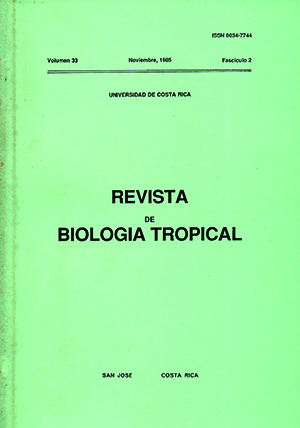Resumen
Se analizó la microflora intestinal de 28 ratones, criados en un bioterio y de 6 ratas silvestres. De cada animal se extrajo el contenido intestinal y se observó al microscopio de contraste de fases y al microscopio electrónico de transmisión. También, se hicieron cultivos en agar de Butzler y agar aeromonas, que fueron incubados en microaerobiosis a 37°C, durante cinco días.
A partir del contenido intestinal de tres de los ratones y de dos de las ratas se observó bacterias helicoidales, con 8 a 1 1 fibras periplásmicas y ramilletes terminales de 8 a 11 estructuras similares a flagelos. También, en una de esas ratas se observó partículas similares a coronavirus. En los cultivos de dos de los ratones se aisló Campylobacter fetus ssp.jejuni y de dos de las ratas se aisló Aeromonas hydrophila.
Citas
Chase, D.G., & S.L. Erlandsen. 1976. Evidence for a complex life cycle and endospore formation in the attached filamentous. segmented bacterium from murine ileum. J. Bacteriol., 127: 572-583.
Davies, C.P., J.S. McAllister, & D. C. Savage. 1973. Microbial colonization of the intestinal epithelium in suckling mice. Infect. Immun., 7: 666-672.
Davies, C.P., D. Malcahy, A. Takeychi, & D. C. Savage. 1972. Location and description of spiral-shaped microorganisms in the normal rat cecum. Infect. Immun., 6: 184-192.
Davies, C. P., & D. C. Savage. 1974. Habitat, succesion, attachment, and morphology of segmented filamentous microbes indigenuous to the murine gastrointestinal tract. Infect. Immun., 10: 948-956.
Gracey, M., V. Baurke, & J. Robinson. 1982. Aeromonas-associated gastroenteritis. Lancet, 2: 1304-1306.
Graevenitz, A. V., & A. Mensch. 1968. The genus Aeromonos in human bacteriology. Report of 30 cases and review of the literature. N. Engl J. Med., 178: 245-249.
Hernández, F., J. Vincenti, & P. Rivera. 1984. Estudio de la movilidad y velocidad bacteriana empleando televisión en circuito cerrado. Rev. Biol. Trop., 32: 309-312.
Karmali, M. A., & P. C. Fleming, 1979. Campylobacter enteritis. CMAJ., 120: 1525-1532.
Ljungh, A., M. Popoff, & T. Wadstrom. 1977. Aeromonas hydrophila in acute diarrheal disease: detection of enterotoxin and biotyping of strains. J. Clin. Microbiol., 6: 96-100.
Paisler, J. W., S. Mirrett, B. A. Laver, M. Rose, & L. B. Reller. 1982. Dark field microscopy of human feces for presumptive diagnosis of Campylobacter fetus subsp. jejuni enteritis. J. am. Microbiol., 15: 61-63.
Phillips, M., & A. Lee. 1983. Isolation and characterization of a spiral bacterium from crypts of rodent gastrointestinal tracts. Appl. Environ. Microbiol., 45: 675-683.
Rivera, P., F. Hernández, R. Rodríguez, & M. L Herrera. 1983. Observaciones sobre la epidemiología de las infecciones por Campylobacter fetus ssp. jejuni. Rev. Med. Hosp. Nal. Niños, 18: 21-29.
Rozee, K. R., D. Cooper, K. Lam, & J. W. Costerton. 1982. Microbial flora of the mouse ileum mucous layer and epithelial surface. Appl. Environ. Microbiol, 43: 1451-1463.
Savage, D.C., & R. V. H. Blumonshine. 1974. Surfacesurface associations in microbial communities populating epithelial habitats in the murine gastrointestinal ecosystem: Scanning electron microscopy. lnfect. Lmmun., 10: 240-250.
Savage, D.C., & J. S. McAllister, 1971. Cecal enlargement and microbial flora in suckling mice given antibacterial drugs. Infect. Immun., 3: 342-349.
Srahman, A. F. M., & J. M. T. Willoughby. 1980. Dysentery-like syndrome associated with Aeromonas hydrophila. Brit. Med. J., 281: 976.
Tzipori, S., K. W. Angus, I. Campbell, & E. W. Cray. 1980. Cryptosporidium: evidence for a single species genus. Infect. Immun., 30: 884-886.
##plugins.facebook.comentarios##

Esta obra está bajo una licencia internacional Creative Commons Atribución 4.0.
Derechos de autor 1985 Revista de Biología Tropical


